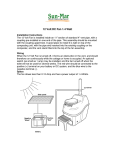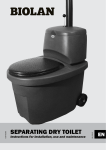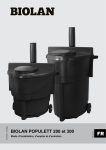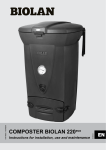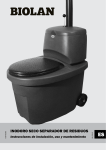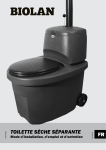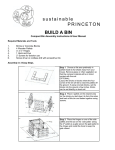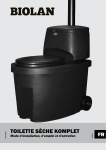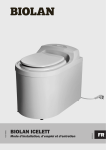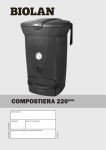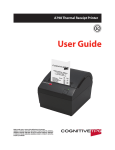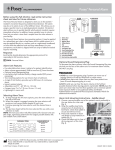Download COMPOSTING TOILET BIOLAN
Transcript
01/2012 70579600 COMPOSTING TOILET BIOLANeco Instructions for installation, use and maintenance 1 103 cm 65 cm 97 cm 65 cm 11 11 cm 54 cm 54 cm ø 7,5 cm 13 cm ø 7,5 cm 45 cm 13 cm 13 cm 13 cm 47 cm 31 cm 39 cm COMPOSTING TOILET BIOLANeco Instructions for installation, use and maintenance The Composting Toilet Biolaneco is an odourless, tidy and environment-friendly toilet. The thermally insulated construction of the composter produces compost rapidly and also enables the composting of household waste. Its operating principle is natural so it requires neither water nor electricity supply. Contents Component list EN-2 1. Planning and installation EN-3 1.1 Technical specifications EN-3 1.2 To be observed if used in winter EN-3 1.3 Locating the Composting Toilet Biolaneco in the toilet spaceEN-3 1.4 Direction of the emptying door EN-3 1.5 Installing the ventilation pipe EN-3 1.6 Leading off the seep liquid EN-4 2. Use and maintenance of the Composting Toilet Biolaneco EN-4 2.1 Before putting the Composting Toilet Biolaneco to use EN-4 2.2 Adjusting the replacement air valve in the seat top EN-4 2.3 Air channel in the toilet tank EN-4 2.4 What can be placed in the Composting Toilet Biolaneco EN-4 2.5 Using bulking material EN-5 2.6 Using the activator EN-5 eco 2.7 Year-round use of the Composting Toilet Biolan EN-5 2.8 Emptying the Composting Toilet Biolaneco EN-5 2.9 Emptying the seep liquid canister EN-5 2.10 Cleaning the Composting Toilet Biolaneco EN-5 3. Post-treatment and use of the compost EN-6 3.1 Need for post-composting EN-6 3.2 Using cover soil EN-6 3.3 Maturing cover soil to compost soil EN-6 3.4 Testing the maturity of the compost soil at home EN-6 4. Problems that may occur EN-6 4.1 Odour EN-6 4.2 Insects or maggots EN-6 4.3 Moisture EN-7 4.4 Liquid runs out from around the emptying door EN-7 4.5 Incomplete composting of waste EN-7 4.6 The mass does not drop down by itself after the emptying EN-7 4.7 The amount of seep liquid entering the canister is larger than normalEN-7 Disposal of the product EN-7 Biolan accessories EN-8 About the guarantee EN-8 EN-1 Component list CompoPart name nent 1 body, mud-brown 2 emptying door latch, 2 pcs. and latch washer, 2 pcs. and latch screw, 2 pcs. 3 emptying door, dark grey 4 inlet air valve body and 5 inlet air valve cover 6 lead-through rubber 30/40 7 liquid separator plate 8 air channel 9 seat top, mud-brown 10 convex sticker 11 thermal seat Pehvakka 12 replacement air valve and replacement air valve body 13 ventilation pipe 1000 mm, 2 pcs. 14 ventilation pipe cap, 75 mm Part No. Material 17792001 40580006 PE + PU EPDM PE RST PE + PU PE PE EPDM PE PE PE + PU PE PP PE PE PE PE 18790950 18792901 19780050 18710141 18792003 17792922 27710360 70578500 18710926 28710241 40580007 In addition to the components illustrated in the components picture, the Composting Toilet Biolaneco also includes: canister for collecting liquid canister cap, with 32 mm hole liquid pipe, 32 mm template user manual Finnish/Swedish user manual in 10 languages (export products only) 16710230 16710270 28578001 27579030 27579010 27579020 PE PE PE PAPER PAPER PAPER 14 13 12 11 9 8 10 7 6 4 5 1 3 2 EN-2 1. Planning and installation When selecting the location for and erecting the Composting Toilet Biolaneco, it is essential to provide sufficient space for use and maintenance of the toilet, to route the ventilation pipe without any bends through the roof over the ridge and to locate the seep liquid canister in a suitable place. See the dimension drawing for the toilet unit (page 2). Place the toilet unit directly on sufficiently firm ground or concrete surface. Do not place the tank on a boarded floor, because of possible seepage from the lower door. 1.1 Technical specifications ------- top area 65 x 65 cm total height to the top 97 cm, to the seat cover 103 cm volume about 200 l weight about 24 kg external diameter of liquid removal hose 32 mm external diameter of ventilation pipe 75 mm, length 2 x 100 cm 1.2To be observed if used in winter If you plan to use the toilet continuously in winter, install the unit in a warm space and also make sure that the drain hose and the seep liquid canister do not freeze. If installing the toilet in a warm space indoors, insulate the ventilation pipe of the toilet where it runs through cold spaces, for example, in the intermediate roof space, to prevent condensation of water. The toilet can be used occasionally in winter (= weekend use) even if the unit is located in a cold space. See point 2.7. 1.3Locating the Composting Toilet Biolaneco in the toilet space Install the Composting Toilet Biolaneco through the floor so that the top of the compost tank (part 9) will serve as the seat ring. The height of the unit is 97 cm and normally the seat height is 45–50 cm. Leave about half of the unit under the floor of the building to achieve a comfortable seat height. Optionally, you can place an appropriate elevation in front of the seat. If you want, you can encapsulate the seat part out of sight. In this case, also provide a hole in the wooden top for the replacement air valve (Part 12). Using for example a keyhole saw or a jig saw, cut a suitable hole for the toilet unit out of the floor using the sawing template as a guide. Depending on the manufacturing technique, the size and shape of the tank vary slightly. This means you may have to enlarge the hole a bit or the seam of the floor and the tank will not be completely tight. You can make the seam neat, for example, by fixing a thick hemp rope at the seam. Example picture of toilet installation and placing the liquid canister. 1.4 Direction of the emptying door You can install the toilet unit with the emptying door (part 3) at its lower part facing either the rear or sidewall of the building. If the emptying door faces the sidewall, turn the seat top of the toilet unit to the sitting position. Remove the top by jerking it firmly. Leave a fair-sized maintenance door (with a minimum width of 80 cm and minimum height of 35 cm) in the lower part of the toilet building for the emptying of toilet waste. 1.5Installing the ventilation pipe There are two Ø 75 mm holes in the seat top – one for the replacement air valve (part 12), the other for the ventilation pipe (part 13). The holes are identical, so as required you can switch the ventilation pipe and the replacement air valve. Route the ventilation pipe from the toilet unit straight up over the roof ridge. Any bends in the ventilation pipe impede natural ventilation, causing odour and moisture problems. Seal the lead-through on the roof using sealant suitable for the roofing material. The sealant can be purchased from any hardware store. Fig. 1 EN-3 If installing the toilet in a warm space indoors, insulate the ventilation pipe of the toilet where it runs through cold spaces, for example, in the intermediate roof space, to prevent condensation of water. If you have to make some bends, take note that the curvature of such bends must not exceed 33 degrees. You can boost the ventilation and evaporation of moisture by means of the optional Biolan Wind Fan (see Accessories on page EN-8). In complicated installations or when installing the Composting Toilet Biolaneco in a residential location, it is recommended to use an additional Biolan Exhaust Ventilator, which can be installed in the ventilation pipe (see Accessories on page EN-8). As required, you can even retrofit the ventilator. Where necessary, the ventilation pipe can be extended using the ordinary grey sewage pipes and fittings (diameter 75 mm). You can purchase ventilation pipes (part 13) also as spare parts from the Biolan web shop or ask your dealer to order these for you. 1.6Leading off the seep liquid The liquid separator plate at the bottom of the Composting Toilet Biolaneco enables separation of excess liquid – the seep liquid – from the compost mass. This plate is removable, so you can take it away for cleaning, as required. Place the plate into the recess in the bottom of the Composting Toilet Biolaneco. Connect the seep liquid pipe to the drain hole in one side of the toilet unit. Route the pipe into a canister. Bury the canister in the ground, or place it some other way so that the seep liquid flows by gravitation into the canister. Keep in mind possible use of the toilet in winter when laying the seep liquid pipe and locating and insulating the canister. Where necessary, the ventilation pipe can be extended using sewage pipes and fittings (75 mm in diameter). You can purchase liquid pipe also as a spare part from the Biolan web shop at www.biolan.fi or ask your dealer to order this for you. Always use sleeves with a sealing ring for joining up the pipes. Route the hose into a canister that you have placed in such a way that the liquid will flow by gravity alone. If you want, you can build an externally insulated pit with a cover of film-faced plywood (as shown in Figure 1 on page 5). If the seep liquid canister is difficult to bury in the ground, you can replace it with a smaller canister or an evaporating pan. The evaporating pan must be provided with an overhead rain lid – non-fertilised Biolan Peat is recommended for neutralisation of odours (see Accessories on page EN-8). If you want, you can lay the canister on its side. The amount of seep liquid from the Composting Toilet Biolaneco is small, depending on the use, about 0.2 to 0.5 litres/user/per day. The seep liquid, however, is extremely rich in nutrients and must not be allowed to enter soil without being treated first. Liquids rich in nutrients must not be allowed to enter the soil as they cause an excessively concentrated nutrient load. 2. Use and maintenance of the Composting Toilet Biolaneco Proper use of the Composting Toilet Biolaneco allows more efficient composting of the mass, and enables more convenient use and emptying of the composter. Thanks to the thermal insulation of the toilet, composting of the waste is efficient and thus the capacity of the toilet unit is increased as the waste is greatly compressed as a result of decomposition. The composting process starts as soon as there is a sufficient amount of waste in the composter, i.e. normally the unit is half-full of waste. The composting process is understood to start when the temperature of the mass inside the toilet rises above the outside air temperature. The temperature is raised and maintained by the vital functions of the micro-organisms that are created in the composter provided that waste is added regularly. After start-up, the waste reaches the cover soil stage in 6-7 weeks. The amount of seep liquid created is greatest at the start, but is reduced as a result of warming up of the compost mass and evaporation. 2.1Before putting the Composting Toilet Biolaneco to use Make sure that the air channel (part 8) inside the compost tank is still in place after transportation. The channel must rest on the sill on the inside wall of the tank so that the inlet air valve (part 5) above the emptying door will allow unobstructed airflow into the air channel. The air inlet valve cannot be adjusted. Put a layer approximately 5 cm thick (about 20 l) of Biolan Compost and Toilet Bulking Material (see Accessories on page EN-8) on the bottom of the Composting Toilet Biolaneco to prevent the liquid separator plate (part 7) from getting blocked. 2.2Adjusting the replacement air valve in the seat top Ventilation of the toilet is controlled by means of the replacement air valve (part 12) in the seat top. Keep the replacement air valve open during summer to ensure the ventilation remains efficient and the evaporation of liquids intensive. Keep the replacement air valve almost closed during winter to reduce heat loss from the compost. When the toilet is not in use, keep the seat lid closed to ensure correct operation of the ventilation. 2.3Air channel in the toilet tank Operation of the Composting Toilet Biolaneco is very effective because of the air channel (part 8) inside the toilet unit. The channel brings the air required by the compost to the centre of the compost mass – to the layer where it is most needed. At the same time, the air channel prevents the compost mass from packing on the bottom and keeps the mass elevated during emptying. The air channel is visible at the initial stage, but after that, it is virtually obscured by the mass all the time. 2.3.1 Adjusting the inlet air valve above the emptying door The inlet air valve above the emptying door (parts 4 and 5) cannot be adjusted. Its purpose is to bring air into the air channel (part 8). See point 2.3. EN-4 2.4What can be placed in the Composting Toilet Biolaneco The Composting Toilet Biolan is intended for composting toilet waste as well as household bio-waste. Kitchen waste intensifies the composting process by balancing and diversifying the nutrition base of the compost. On the other hand, there are risks involved in composting kitchen waste. Pieces of meat and fish, especially when left in the open, may attract flies into the compost tank. Cover the waste with bulking material with care. eco Do not put into the toilet anything that hampers the composting process or does not compost, such as: -- debris, sanitary towels -- chemicals, lime -- detergents, washing water -- ash, cigarette butts, matches You can put into the toilet paper towelettes intended for cleaning hands or for intimate hygiene. 2.5Using bulking material After every time the toilet is used, apply approximately 0.2-0.5 litres of Biolan Compost and Toilet Bulking Material over the left matter. Note that bulking material must also be applied after urinating. Applying suitable bulking material is essential for proper operation of the toilet. For bedding we recommend Biolan Compost and Toilet Bulking Material (see Accessories on page EN-8). 2.6 Using the activator Do not use activator in the toilet. It is not necessary, as the nitrogen content of the toilet waste is sufficient even without addition of the activator. 2.7 Year-round use of the Composting Toilet Biolaneco 2.9 Emptying the seep liquid canister Keep an eye on the filling pace of the seep liquid canister, in particular at the initial stage of use, until the emptying interval settles down. Empty the seep liquid canister as required, however, at least once a year. You can utilise the seep liquid, that is rich in nutrients, as a source of nitrogen for compost. This intensifies the activity of in particular the garden compost, which is poor in nutrients but rich in carbon. This way, you do not have to dilute the seep liquid. You can also use seep liquid as fertiliser for ornamental plants in the yard and garden. A safe dilution ratio is 1:5. Undiluted seep liquid can also be used, but then you must water the area carefully after the application to avoid early blight. Fertilising in the autumn is not recommended so as not to disturb the preparation of perennial plants for winter. The recommended storing time for the seep liquid before use as fertiliser is approximately one year. Please consult your local waste advisor for regulations on composting. Visit www.biolan.fi for more information on composting and the utilisation of urine. 2.10 Cleaning the Composting Toilet Biolaneco As required, you can remove the thermal seat of the Composting Toilet Biolaneco, and wash it using any common domestic cleaning agents. Likewise, you can wash the unit externally using domestic cleaning agents. There is no need to wash the toilet tank internally when emptying it. Check the seep liquid pipe and the liquid separator plate as well as the seep liquid chute below it once a year and clean them, as required. In a toilet located in a non-heated space, the mass will cool down and may even freeze in severe frost or if the use is occasional. Freezing damages neither the unit nor the compost mass itself and the composting process continues when the temperature rises. To reduce leakage of the seep liquid, we recommend using a double dosage of Biolan Compost and Toilet Bulking Material in the winter. Empty the seep liquid canister in the autumn to prevent it from cracking due to freezing. Empty the toilet unit approximately to half-full in the autumn to provide space for the mass that will accumulate in the winter. If the toilet is to be used daily also during the cold season, locate the unit in a heated space. See point 1.2. 2.8 Emptying the Composting Toilet Biolaneco Only empty from the Composting Toilet Biolaneco compost that has reached the cover soil stage, and leave the raw waste still in the tank. To enable an efficient uninterrupted composting process, we recommend that no more than half of the mass be discharged from the unit at a time. Toilet waste matures to cover soil stage in 5-8 weeks, after which it can be emptied. Do not empty the tank until it has become full for the first time. There is no need to wash the toilet tank internally when emptying it. Toilet waste can be so tough that it does not drop down onto the bottom of the toilet unit by itself after the emptying. If this is the case, push the mass down using a stick or the Compostmixer (see Accessories on page EN-8). This is easiest to begin from the corners. Be careful not to break the air channel (part 8) in the centre of the toilet unit. If the toilet is to be used only in summer, empty it in spring before using it for the first time. The emptying process is most convenient and easiest at this stage. If the compost mass is still frozen during emptying, thaw it by pouring a bucket of hot water through the seat ring opening a few hours before emptying. EN-5 3. Post-treatment and use of the compost 4. Problems that may occur 3.1 Need for post-composting If correctly installed, used and maintained, the room space where the Biolan Composting Toileteco is located, remains odourless. Odour occurs only for a short while after the seat ring lid is lifted up. This is normal with natural ventilation. If continuous odour problems persist: -- check that the ventilation pipe has not been blocked. -- check that the ventilation pipe is routed from the toilet unit (part 13) straight up to the roof, and that it extends over the roof ridge. If the ventilation pipe is not straight or does not extend over the roof ridge, repair the installation or improve the ventilation by installing a separate Biolan Exhaust Ventilator or a Biolan Wind Fan (see Accessories on page EN-8). You can also improve the ventilation by extending the ventilation pipe. -- make sure that the seep liquid removal system is operational: the excessive liquid is separated into the canister and will not spill out from the emptying door to a large extent. As required, clean the liquid separator plate (part 7), the seep liquid chute and the seep liquid pipe. -- make sure that the bulking material used is Biolan Compost and Toilet Bulking Material (see Accessories on page EN-8). If a mixture of peat and wood shavings or other beddings of fine texture is used, the compost mass may be packed too tightly. -- make sure that a sufficient amount of Biolan Compost and Toilet Bulking Material, about 0.2-0.5 litres, has been applied after each use. Note that bulking material must also be applied after urinating. Compost soil changes and develops constantly. It should be used in a different manner in different stages of its development. Typically compost soil is divided into two groups based on its maturity: cover soil and compost soil. In general, the compost mass emptied from the Composting Toilet Biolaneco has already matured to the cover soil stage. Because of seep liquid leaching through the compost, the compost is recommended exclusively for ornamental plants. If you intend to use it for a vegetable plot, post-compost it for about a year in order to exterminate microbes. During post-composting the cover soil matures into compost soil. Correctly used, the compost soil is excellent soil conditioner and fertiliser to plants. 3.2Using cover soil By cover soil we mean the semi-mature compost mass. At this stage, decomposing has reached a level where toilet waste and possible food waste have already decomposed. Harder wood matter and, for example, eggshells and citrus fruit peels may not yet have completely decomposed; thus the cover soil has quite a rough look. In the Composting Toilet Biolaneco, this stage is reached in 5 to 8 weeks. The semi-mature compost soil may still possess substances that prevent growth. Hence it must not be used as growing substrate. The cover soil, i.e. the half-mature compost, is not harmful to the plants, if it is spread to cover the planting area of ornamental plants as a layer of a few centimetres. A suitable thickness for the layer to be applied is about 2-5 cm. 3.3Maturing cover soil to compost soil If the cover soil is post-composted, it will mature into proper compost soil. You can post-compost the cover soil, for example, in a stack or in a non-insulated composter, because maturing compost soil does not heat up any longer. For post-composting, it is advisable to use a composter with a cover, such as (e.g.) the Biolan Garden Composter (see Accessories on page EN-8) or the Biolan Stone Composter (see Accessories on page EN-8) to prevent rainwater from flushing away the water-soluble nutrients. In about a year, the compost matures into compost soil of a dark brown colour and aggregate structure, from which source substances, except for bigger wood splinters, can no longer be distinguished. 3.4 Testing the maturity of the compost soil at home The maturity of the compost soil can easily be tested at home by sprouting garden cress. -- Fill two pots: one with compost and the other one with growth peat. -- Sow the seeds, cover with plastic and place the pots in a sunny place. -- In two weeks you can judge from the result whether the compost is sufficiently mature or not. If the plants sprout significantly better in the pot with peat, the compost still contains substances that impede growth. The compost is not mature, if the seeds germinate, but the plants soon wither away. EN-6 4.1Odour 4.2Insects or maggots The most common flies in the composting toilets are small fungus gnats, fruit flies etc. Using a fly net does not prevent these tiny flies from entering the compost. The fly maggots are light in colour, and can try to get out of the toilet unit via the seat part, if the conditions inside the toilet are too hot for them. The presence of flies in the compost often indicates that the compost mass is too wet. See also point 4.3. -- make sure that the bulking material used is Biolan Compost and Toilet Bulking Material (see Accessories on page EN-8). Some beddings (e.g. fresh chips of deciduous trees) attract flies to the compost. The pine bark used in the Biolan Compost and Toilet Bulking Material, however, acts as a repellent. -- add a thick layer of bulking material on top of the compost. -- do away with any flying insects in the toilet space using pyrethrin-based spray. Consult your local garden centre to select a suitable product. Repeat the spraying at intervals of at least two-three days to exterminate the new generations emerging from eggs and maggots. Spray insecticide also inside the toilet unit and close the lid. Repeat the spraying until flying insects no longer can be spotted. 4.3Moisture When the composting process is at its most effective, it is normal that the bottom surface of the seat ring lid is moist. However, if there is a lot of moisture on the seat ring lid and on the sides of the seat ring, something is wrong. Normally the problem occurs in the air outlet system or in the liquid separator system. -- make sure that the replacement air valve (part 12) in the seat top is open. -- make sure that the ventilation pipe (part 13) has not been blocked. -- check that the ventilation pipe is routed from the toilet unit straight up to the roof, and that it extends over the roof ridge. If the ventilation pipe is not straight or does not extend over the roof ridge, you can repair the installation or improve the ventilation by installing a separate Biolan Exhaust Ventilator or a Biolan Wind Fan (see Accessories on page EN-8). You can also improve the ventilation by extending the ventilation pipe. -- make sure that the seep liquid removal system is operational: the excessive liquid is separated into the canister and will not spill out from the emptying door to a large extent. As required, clean the liquid separator plate (part 7), the seep liquid chute and the seep liquid pipe. -- make sure that the bulking material used is Biolan Compost and Toilet Bulking Material (see Accessories on page EN-8). -- make sure that a sufficient amount of Biolan Compost and Toilet Bulking Material, about 0.2-0.5 litres, has been applied after each use. It may prove necessary to double the usage of bulking material temporarily. 4.4Liquid runs out from around the emptying door At the initial stage, when the toilet is still half empty, or in the case of overloading, some liquid may leak out from around the emptying door. -- if it is not a question of initial stage of use or an overloading situation, clarify potential reasons in accordance with point 4.3. 4.5Incomplete composting of waste The reason for incomplete composting of waste is usually that the mass is either too dry or too wet. If a lot of decomposed toilet paper is detected while emptying the compost, the amount of liquid has been too small in relation to the volume of dry matter. -- make sure that the amount of urine supplied into the toilet is sufficient. If this is not the case, some liquid must be added. Urine is best for the purpose, but even water will do. If the compost is wet or reeks when emptied, its liquid content is too high. -- make sure that the seep liquid removal system is operational: the excessive liquid is separated into the canister and will not spill out from the emptying door (part 3) to a large extent. As required, clean the liquid separator plate (part 7), the seep liquid chute and the seep liquid pipe. If the liquid separator system is working properly, the mass is wet for some other reason. -- make sure that the bulking material used is Biolan Compost and Toilet Bulking Material (see Accessories on page EN-8). -- make sure that a sufficient amount of Biolan Compost and Toilet Bulking Material, about 0.2-0.5 litres, has been applied after each use. -- make sure that the replacement air valve (part 12) in the seat top is open. -- check that the ventilation pipe has not been blocked. -- check that the ventilation pipe is routed from the toilet unit (part 13) straight up to the roof, and that it extends over the roof ridge. If the ventilation pipe is not straight or does not extend over the roof ridge, you can repair the installation or improve the ventilation by installing a separate Biolan Exhaust Ventilator or a Biolan Wind Fan (see Accessories on page EN-8). You can also improve the ventilation by extending the ventilation pipe. 4.6 The mass does not drop down by itself after the emptying It is normal that the toilet waste is tough, sticks to the toilet walls, and does not drop down by itself after the emptying. -- drop the mass down by pushing through the seat opening using either the Compostmixer (see Accessories on page EN-8) or a sturdy stick. Dropping is easiest to begin from the corners. Be careful not to break the air channel (part 8) in the centre of the toilet unit. 4.7 The amount of seep liquid entering the canister is larger than normal Usually the amount of seep liquid accumulated in the canister is about 0.2-0.5 litres/user/day of operation. If the amount of liquid accumulated is larger than this -- check the potential reasons in accordance with point 4.3. -- also note that the amount of seep liquid extracted at the initial stage of use is usually larger than in normal use and stabilises over time as the toilet is filled with composting mass. -- check whether the way the toilet is used has changed, or if overloading has occurred. Disposal of the product The raw materials used are presented in the component list (see page 4). Dispose of each part as prescribed. Always follow the regional and collecting-point-specific instructions. To energy-from-waste process or recycling of plastic: EPDM = ethylene propylene PE = polyethylene PP = polypropylene To energy-from-waste process: PU = polyurethane To collection of metal: RST = stainless steel To recycling of paper: Paper EN-7 Biolan accessories Availability varies from country to country. Consult your local dealer for details. Biolan Compost and Toilet Bulking Material is a blend of pure, dried and ground conifer bark, wood and peat for composting and dry toilets. Applying it regularly to the compost keeps the compost mass airy and ensures the composting is efficient and odourless. Package size: a bag of 40 litres, a bag of 85 litres Product number: 40 l 70562100, 85 l 70562500 HVAC code: 40 litres 3663112, 85 litres 3663122 Biolan Peat Biolan Peat is clean, white non-fertilised or limed sphagnum peat. It is naturally sour. Biolan Peat is suitable for, for example, storing root crop, use as soil conditioner, and use in an evaporating pan for seep liquid. Package size: a bag of 70 litres Product number: 55544200 Biolan Pehvakka Biolan Pehvakka is a hinged thermal seat, which is hygienic and durable. The flexible foam material neither cracks in use nor absorbs moisture. Both the lid and the seat ring can be lifted up, which makes thorough cleaning of the seat easier. It can be cleaned using any common domestic cleaning agents. The seat can be fitted in toilets where the distance between the hinge pins is either 16 cm or 18 cm. Product number: 70578500 HVAC code: 3663115 Biolan Wind Fan The Biolan Wind Fan is an efficient exhaust fan that is powered by the wind. It is ideal for improving the ventilation in warehouses, dry toilets, bathrooms, small scale water treatment plants etc, and locations that need good ventilation. The Wind Fan is made of aluminium, and thanks to its very mobile bearing, even a slight breeze can improve ventilation significantly. Product number: 70572500 HVAC code: 3663109 Biolan Exhaust Ventilator The Exhaust Ventilator with electric drive is designed to improve the ventilation of the dry toilet. The connectors of the Exhaust Ventilator fit directly onto a pipe 75 mm in diameter. The ventilator only requires electric power of about 10 W. The ventilator operates with a voltage of 12 V and its rotational speed can be adjusted using the transformer included in the package. Product number: black 70575410, white 705420 HVAC-code: black 3663110, white 3663125 EN-8 Biolan Garden Composter The Biolan Garden Composter is intended for the composting of domestic, garden and toilet waste in a detached house or a holiday home. Its large, hinged cover makes the filling of the composter easier. The hermetic structure and adjustable air exchange prevent the compost mass from drying, and reduce the need for maintenance. Product number: green 70572000, grey 70576700 Biolan Stone Composter The Biolan Stone Composter is intended for the composting of domestic and garden waste in a detached house or holiday home. Thanks to its large size, it is wellsuited to the composting of garden waste and toilet waste from a summer cottage. Biolan Stone Composter having the colour of natural stone merges well with its surroundings, and is well-suited even to small yards. Product number: red granite 70573100, grey granite 70573200 Biolan Compostmixer The Biolan Compostmixer is made of glass fibre-reinforced propene, so it neither corrodes nor oxidises even over time. The Biolan Compostmixer offers effortless mixing of the compost. Product number: 70575200 Biolan Suotis Biolan Suotis is a biochemical seep liquid filter for a dry toilet. The device cleans up the seep liquid so that it can be conducted directly to the nature. The filter operates by gravitation and does not need any electricity supply. The capacity of the device is 60 litres. Product number: 70572100 HVAC code: 3623612 About the guarantee The Composting Toilet Biolaneco is guaranteed for one year 1. The guarantee is valid from the date of purchase and covers possible defects in material and workmanship. The guarantee does not cover any indirect damage. 2. Biolan Oy retains the right to decide about repairing or replacing damaged parts at its discretion. 3. Any damage resulting from careless or forcible handling of the device, from failure to observe the operating instructions, or from normal wear, will not be covered by this guarantee. For matters related to the guarantee, please consult Biolan Oy directly. Biolan Oy P.O. Box 2, FI-27501 KAUTTUA Tel. +358 2 5491 600 www.biolan.fi 01/2012 Biolan Compost and Toilet Bulking Material












